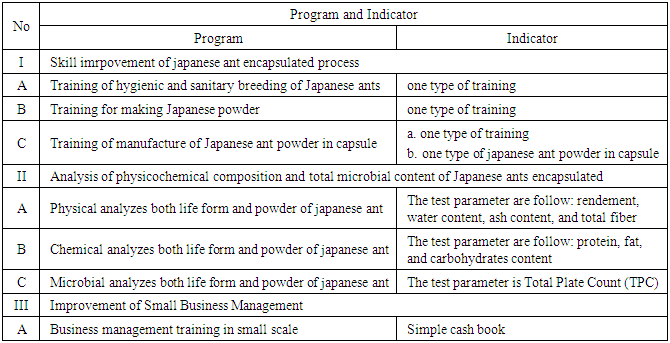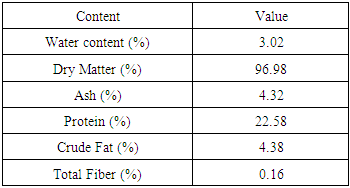-
Paper Information
- Paper Submission
-
Journal Information
- About This Journal
- Editorial Board
- Current Issue
- Archive
- Author Guidelines
- Contact Us
Management
p-ISSN: 2162-9374 e-ISSN: 2162-8416
2017; 7(4): 157-160
doi:10.5923/j.mm.20170704.03

Empowerment of Japanese Ants Small Business by Hygiene and Management Training: A Case Study of Malang East Java Indonesia
Wahyu Mushollaeni, Lorine Tantalu, Endang Rusdiana
Agroindustrial Technology Department, University of Tribhuwana Tunggadewi, Malang, Indonesia
Correspondence to: Wahyu Mushollaeni, Agroindustrial Technology Department, University of Tribhuwana Tunggadewi, Malang, Indonesia.
| Email: |  |
Copyright © 2017 Scientific & Academic Publishing. All Rights Reserved.
This work is licensed under the Creative Commons Attribution International License (CC BY).
http://creativecommons.org/licenses/by/4.0/

Japanese ant (Tenebrio molitor) has been known as alternative of diabetes treatment by lowering uric acid levels. The present status of scientific review of Japanese ant as an alternative medicine still unknown even breeding has been made up. Anang Jaya and Wariadi Enterprises were success example of small-scale breeder and seller of japanese ants. Good sanitation, hygiene in process and transport handling specific in capsule form has been offered. Here, major training about simple sanitation standard, nutritional composition and microbial content, as well as business management has been done. Result of physicochemical analysis showed that system in Japanese ant bred has higher protein content than beef (16-21%). Protein and fat content equals to 22.58% and 4.85%. Moreover, water content, ash, fiber, total dry matter, and rendement of Japanese ant powder respectively 3.02%; 4.32%; 0.16%; 96.98%; and 97%. Microbial analysis gave total reduction up to 3.1x105 to the lower of 3.0 x 102. Improvement in management side by presence of a simple, centralized cash book was applied and managed by the Anang Jaya group might effects in clear cash flow calculations and better business profit sharing.
Keywords: Japanese ants (Tenebrio molitor), Sanitation and hygiene, Capsule, Protein
Cite this paper: Wahyu Mushollaeni, Lorine Tantalu, Endang Rusdiana, Empowerment of Japanese Ants Small Business by Hygiene and Management Training: A Case Study of Malang East Java Indonesia, Management, Vol. 7 No. 4, 2017, pp. 157-160. doi: 10.5923/j.mm.20170704.03.
Article Outline
1. Introduction
- Japanese ant (Tenebrio molitor) is a type of insect which is in larvae stage become a caterpillar and general used as feed. This insect has been extensively reported could be an alternative medicine especially for diabetes, coroner, and some of chronic diseases treatment [1-3]. This high benefits may great influence the demand for Japanese ants in some product. Recently, the Japanese ant has been cultivated on bulk in some region. [2, 4, 5].
 | Figure 1. Tenebrio molitor |
2. General Condition of Japanese Ants Business Group and Problems
- Anang Jaya and Wariadi breeder business are located in Malang City, which is be conducted by Mr. Anang and consists of 3 youth labor from Dinoyo, Sumbersari Malang. Mr. Anang has experienced to cultivated the bird and instruct the to be chirping bird. The most cultivated of chirping birds is canaries, followed by poksai, magpies, and spears. Mr. Anang labors are out-of-school youth and unemployment consist of 5 people between 30 – 40 years old which gain their capability as breeder and raised profit since they get down in business. Exchanging information by fellow sellers, join in singing bird communities, and fellow in bird race competition may give the best method to build chirping bird, and cultivate ornamental bird and japanese ant. The agreement on both producers imply the synergize in terms of provision of seeds, breeders and sales of birds twitter of both since business have began, so that their business can survive. Both businesses quite productive and have great possibilities to develop into independent community business, otherwise assistance and business coaching in terms of production and business management need requirement.The recently described preliminary surveys in Anang Jaya business, which found some deficiency due to maintenance equipment, how to handle Japanese ants during marketing and sales, and also business management aspects. The major difficulty of selling is about the service and marketing coverage. High demand of the product by the producer due to lacking facilities still be main problem. Nowadays, marketing has been constrained by the form of the product, the life form which still has to cultivate until consume by customer. They have to swallow the life form brewed with water, which is lead hesitate or beastly either for the consumers. As above mentioned that in preliminary survey result that for hygiene handling and information on the nutritional components contained in the Japanese ant product as alternative medicines in deficiency status. The survey was also conducted on the consumer to know the superiority of Japanese ants produced by the Anang Jaya producer. Customers stated that Japanese ants produced by both producers have good quality, including the color of black or brown with the thick ± 1-2 cm. Consumers also expressed quite satisfied with the services of Mr. Anang and members due to existence of delivery orders almost in time, offer cheaper prices and help the preparation of Japanese ants in home. Therefore, appropriate technology much needed to construct the platform and made Japanese ant consuming could be easier. Scientific information about the consumption dozes and nutritional composition contained in Japanese ant product also be considered as one form of customer service so that will widespread the range of consumers and marketing areas.
3. Implementing Activities Method and Problem Solving
- Advisory and technical guidance programs are carried out at the Anang Jaya and Wariadi breeder business synergistically and together. In this study, we evaluated and trained sanitation during breed of Japanese ant capsule-making process, and small business management training. Throughout the training, nutritional composition and microbial content of Japanese ants were analyzed. The stages of activities are:1. Skill improvement of japanese ant encapsulated process a. Training of hygienic and sanitary breeding of Japanese ants,b. Training for making Japanese powder c. Training of manufacture of Japanese ant powder in capsule 2. Analysis of physicochemical composition and total microbial content of Japanese ants encapsulated3. Business management training in small scale Physical, chemical and microbiological analyzes of life and/or powdered forms of Japanese ant were carried out in the Laboratory of Process Engineering UNITRI and THP UB Malang Laboratory. Analysis of physical and chemical parameters based on the AOAC standard [8] which includes rendement, moisture content, ash content, fiber content, protein content, fat content and carbohydrate levels. Microbiological analysis of the product is total bacteria or Total Plate Count (TPC) [9].
4. Result and Achievement Indicators
4.1. Completed Program
- Several problems related to the lack of information on sanitation and hygiene was found preliminary surveys. The weakness business management as follows:1. Great sanitation has not implemented yet in handling process of Japanese ants 2. Vary mortality rate of Japanese ants producing are quite high3. Living condition was chosen as marketing design and may not efficient4. Information about superiority in terms of scientific and nutritional composition of the product does not exist yet5. Simple financial management still may not be exist, so remain unclear and may have not transparencyProblem no. 1-5 due to a technical problem and requires assistance in improving product quality, including sanitary conditions among breeding, encapsulated process and packaging. Particularly for 5th issue is a matter of business management. The existing problems may influence the credibility of the product, especially on the physical and chemical qualities, as well as low member revenues. Preliminary analysis is also performed on customers from both breeder partners, regarding on satisfaction of partner products and services. The results of consumer responses show that there are satisfied with the services and prices offered by both partners in general. Affordable price as well as delivery order and preparation supplies at consumer homes has offered. Therefore, the problem-solving program which is done and has been achieved the target is directed towards performance indicator. It may lead increasing partner productivity and making the business more independent, as indicated of the improvement indicators in every activity stage. (Table 1).
|
4.2. Physicochemical and Microbial Analysis
- The result of physicochemical analysis showed in Table 2 which is showed that protein content of japanese ants was 22.58% higher than chicken protein which equal to 18.20% [9] and 21.80% [11]. Protein content of Japanese ants indicated that it was include in standard limits of protein content that should be present in the meat of 23.20% [12]. Japanese ant crude fat equal to 4.85% which higher than chicken meat is 2.68-2.86% [13], whereas almost equivalent to the USDA requirement of 4.31% [12]. Water content, dry matter, ash content, and total fiber from both business groups which apply sanitary and hygienic system, respectively 3.02%; 96.98%; 4.32%; And 0.16%.
|
 | Figure 2. Japanese ant breeding (a, b). Dryer instrument of Japanese ant (c). Drying process of Japanese ant (d, f). Japanese ant powder (e) |
5. Conclusions
- The results of physicochemical analysis showed that Japanese ants which have been bred hygienically have excellent nutritional content, specifically for protein content is higher than the general beef protein (16-21%). The protein and fat content were 22.58% and 4.85%, while the water content, ash, fiber, total dry matter, and rendement of Japanese ant powder respectively were 3.02%; 4.32%; 0.16%; 96.98%; And 97%. Hygienic bred may caused Japanese ants has resulted in a total reduction of the microbial from the initial condition of 3.1x105 to the lower of 3.0x102. The improvement in the management side is the presence of a simple, centralized cash book managed by the Anang Jaya breeder business, so that there are clear cash flow calculations and better business profit sharing.
ACKNOWLEDGEMENTS
- The authors thank to Indonesian government funding for Community Servive Program-IbM Grants 2017 (Ministry of Research, Technology and Higher Education).
 Abstract
Abstract Reference
Reference Full-Text PDF
Full-Text PDF Full-text HTML
Full-text HTML
